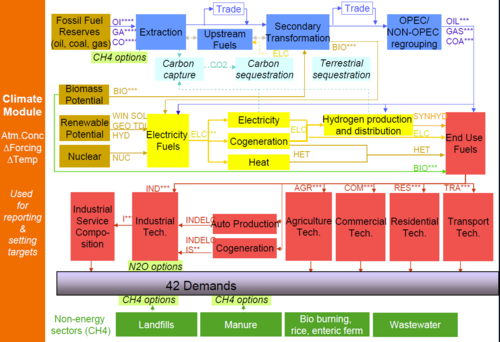Model concept, solver and details - TIAM-UCL: Difference between revisions
No edit summary |
No edit summary |
||
| Line 9: | Line 9: | ||
[[File:RES system.png|500px|thumb|centre|Figure 1.1: Simplified Reference Energy System in TIAM Source: Loulou and Labriet (2007)]] | <figure id="fig:myobject"> | ||
[[File:RES system.png|500px|thumb|centre|<caption>Figure 1.1: Simplified Reference Energy System in TIAM Source: Loulou and Labriet (2007)</caption>]] | |||
</figure> | |||
Revision as of 13:19, 10 October 2016
| Corresponding documentation | |
|---|---|
| Previous versions | |
| Model information | |
| Model link | |
| Institution | University College London (UCL), UK, https://www.ucl.ac.uk. |
| Solution concept | Partial equilibrium (price elastic demand) |
| Solution method | Linear optimisation |
| Anticipation | Perfect Foresight
(Stochastic and myopic runs are also possible) |
TIAM-UCL is a bottom-up, technology-rich cost optimisation integrated assessment model created to assess global decarbonisation pathways in terms of the global temperature change.
The main building blocks of TIAM-UCL is a TIMES model which includes processes and commodities, which are connected by commodity flows in a network representation called a Reference Energy System (RES). The dynamic part of a model is determined by the time horizon and resolution, the evolutionary development of supply and technologies, the growth of the demand for energy services, and policies (e.g., mitigation targets, renewable portfolio standards), complimented by various alternate scenarios.
<figure id="fig:myobject">
</figure>
In each region, the TIAM-UCL model describes the entire energy system by all essential current and future energy technologies from the primary energy supply over the processing, conversion, transport, distribution of energy carriers to the end-use sectors and the useful energy demand.These demands are linked to exogenous underlying drivers, like population growth or GDP development, via demand elasticities. Each region can trade one or more resources (fossil fuels and biomass) with other regions. Regional trade will depend on demand, supply (resource availability) and cost (resource and transportation cost) of the resources.
Base-year energy-service demands are exogenous and are projected over 2005-2100 using drivers such as GDP, population, household, sector output etc. The base-year final energy consumption is calibrated in the Base-Year templates. Separate Base-Year templates are available for each region for end-use sectors, upstream and the electricity generation sector. A representation of all existing technologies and resources are included in the Base-Year templates. Technologies available for the future years are modelled in a separate module called 'New Technologies'. Any region can access the technology module if it is cost effective to do so. Resource data such as cost, cumulative and annual availability of different resources are modelled in the 'Resource Module'. The world regions are linked through the trade of goods via the trade module. There are separate modules available for hydrogen production, carbon sequestration, land-use CO2 emissions, N2O measures, CH4 measures, etc. Climate module calculates impacts of GHG emissions in the Atmosphere (CO2 concentration and temperature changes). Beside these modules, there are several scenario files which are used to apply different policies and constraints.
Further details on the TIAM model structure is available in Loulou and Labriet (2007).
The underlying data for the base year calibration in TIAM-UCL is the IEA Extended Energy Balances of OECD and non-OECD countries.
Software
TIAM is a whole energy system model covering from energy resources to conversion to infrastructure to end-use sectors.This is a linear programming model that minimises total discounted energy system cost in the standard version and maximises societal welfare (total surplus) in the elastic demand version to compute a partial equilibrium.Linear programming is formulated in the GAMS (General Algebraic Modelling System) language and solved via powerful linear programming optimisers (CPLEX, XPRESS).
VEDA Front-End (VEDA_FE) is one of the two interfaces available for MARKAL and TIMES model. It is used to formulate the TIAM-UCL model database that lay down the basic structure of the model and hold fundamental data and assumptions for processes (technologies) and commodities. VEDA is a set of tools geared to facilitate the creation, maintenance, browsing, and modification of the large data bases required by complex mathematical and economic models. Data and assumptions are fed into VEDA_FE that provides input to the TIMES code. VEDA_FE accepts input from a variety of Excel files with different (flexible) structures that are tailored to work efficiently with data intensive models.
